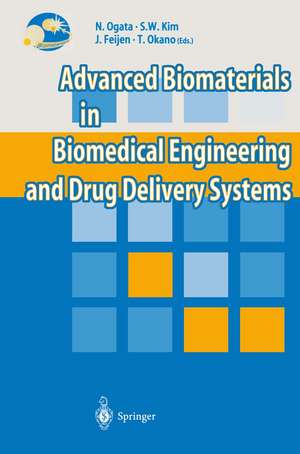Advanced Biomaterials in Biomedical Engineering and Drug Delivery Systems
Editat de Naoya Ogata, Sung W. Kim, Jan Feijen, Teruo Okanoen Limba Engleză Paperback – 20 apr 2014
Preț: 951.67 lei
Preț vechi: 1160.57 lei
-18% Nou
Puncte Express: 1428
Preț estimativ în valută:
182.13€ • 189.44$ • 150.35£
182.13€ • 189.44$ • 150.35£
Carte tipărită la comandă
Livrare economică 15-29 aprilie
Preluare comenzi: 021 569.72.76
Specificații
ISBN-13: 9784431658856
ISBN-10: 4431658858
Pagini: 381
Ilustrații: XXIV, 381 p. 147 illus.
Dimensiuni: 155 x 235 x 27 mm
Greutate: 0.62 kg
Ediția:Softcover reprint of the original 1st ed. 1996
Editura: Springer
Colecția Springer
Locul publicării:Tokyo, Japan
ISBN-10: 4431658858
Pagini: 381
Ilustrații: XXIV, 381 p. 147 illus.
Dimensiuni: 155 x 235 x 27 mm
Greutate: 0.62 kg
Ediția:Softcover reprint of the original 1st ed. 1996
Editura: Springer
Colecția Springer
Locul publicării:Tokyo, Japan
Public țintă
ResearchDescriere
First of all, I would like to share the great pleasure of the successful five-day symposium with every participant in the 5th Iketani Conference which was held in Kagoshima from April1S (Tuesday) to 22 (Saturday), 1995. Outstanding speakers enthusiastically presented their up-to-the-minute results. Relatively little time was allotted for each presentation to ensure asdnuch time· as possible for intensive discussions on the particular topics that had just been p~esented: I was delighted to see that the lectures were of high quality, and the discu,ssionswere lively, exciting, and productive in a congenial atmosphere. We also had 92 papers in the poster ·session, in which young (and relatively young) scientists made every effort to present the novel results of their research in advanced biomaterials and drug delivery systems (DDS). I believe some of the research is most promising and will become noteworthy in the twenty-first century. It was a privilege for me to deliver a lecture at the special session of the symposium. In my introductory remarks, I pointed out five key terms in multifaceted biomaterials research: materials design, concept or methodology, devices, properties demanded, and fundamentals. I am confident that innovative progress in device manufacturing for end-use, e.g., artificial organs, vascular grafts, and DDS, can be brought about only through properly designed advanced materials that exhibit the desired functionality at the interface with any living body.
Cuprins
Advanced Biomaterials.- Controlled Release Systems Using Swellable Random and Block Copolymers and Terpolymers.- Polymer Gel—A New Type of Soft Energy Transducer.- Communicating with the Building Blocks of Life Using Advanced Macromolecular Transducers.- Water-Soluble Nucleic Acid Analogs—Preparation and Properties.- Intelligent Materials.- Functional Synthetic and Semisynthetic Polymers in Biomedical Applications.- Bioconjugates from Synthetic Polymers—How They Can Be Married?.- Plasma Modification of Polymeric Surfaces for Biomedical Applications.- New Polymeric Materials Design for Biomedical Applications.- Novel Approaches to Drug Delivery Systems and Future Trends.- New Oral Drug Delivery System.- Penetration of Polymeric Drug Carriers into K562 Cells.- Novel Bioadhesive, pH- and Temperature-Sensitive Graft Copolymers for Prolonged Mucosal Drug Delivery.- Enhanced Intestinal Absorption of Peptides by Complexation of the Partially Denatured Peptide.- Controlled Drug Delivery Formulation with Safe Polymers.- Supramolecular Assemblies for Improved Drug Delivery System.- Biodegradable Polyphosphazenes for Biomedical Applications.- Receptor-Mediated Cell Specific Delivery of Drugs to the Liver and Kidney.- Biorecognizable Biomedical Polymers.- Nanoscopic Vehicles with Core-Shell Structure for Drug Targeting.- Third Phase in Polymer Drug Development—SMANCS As a Prototype Model Drug for Cancer Treatment.- Development of a Tetracycline Delivery System for the Treatment of Periodontal Disease Using a Semisolid Poly(ortho ester).- Mechanistic Aspects of Transdermal Drug Transport.- Transbuccal Delivery of Polar Compounds.- Receptor-Mediated Targeting of Peptides and Proteins.- Temperature Sensitive Polymers for Delivery of Macromolecular Drugs.- Biomedical Engineering.- Novel Biomaterials As Artifical Cornea via Plasma Induced Grafted Polymerization.- Ultrathin Polymeric Films As Biomedical Interfaces of Controlled Chemical Architecture.- Randomness and Biospecificity: Random Copolymers Are Endowed with Biospecific Properties.- Strategy and Bionic Design of Vital Functioning Vascular Wall Reconstruction.- Surface Modification of Biomaterials by Topographic and Chemical Patterning.- Interleukin-4 Mediated Foreign Body Giant Cell Formation and Cytoskeletal Rearrangement on Poly(etherurethane urea) In Vivo and In Vitro.- Polymer-Supported Tissue Engineering.- New Frontier of Biomimetic Glycotechnology for Cellular and Tissue Engineering.- Control of Healing with Photopolymerizable Biodegradable Hydrogels.- A Novel Biomaterial: Aramid-Silicone Resin.- Gradient Surfaces As Tools to Study Biocompatibility.- Preparation of Self-Assembled Biomimetic Membranes and Their Functions.- Synthesis and Cell-Adhesion Properties of Polyurethanes Containing Covalently Grafted RGD-Peptides.- Biomaterials and Biomedical Engineering.- One Pot Synthesis of Poly(ethylene oxide) with a Cyano Group at One End and a Hydroxyl Group at the Other End.- Creation of New Si-Containing Block Copolymer Membrane with Both High Gas Permeability and Blood Compatibility.- Surface Modification of Poly(lactic acid) with Bioactive Peptides.- Adsorption of Biomolecules onto Multiblock Copolymer Consisting of Aromatic Polyamide and Poly(dimethylsiloxane).- Hemocompatible Cellulose Dialysis Membrane Modified with Phospholipid Polymer.- Artificial Glycoconjugate Polymers: Cell-Specific Biomedical Materials Using Carbohydrates As Recognition Signals.- Preparation of Acrylamide Coated PVC Tube by APG Treatment and Its Characterization.- Anticoagulant Properties of Sulfonated Glucoside-Bearing Polymer.- Histological and Morphological Comparison of Explanted Small Diameter PU and ePTFE Vascular Prostheses: A Preliminary Study.- Poly(acrylamides) Containing Sugar Residues: Synthesis, Characterization and Cell Compatibility Studies.- Molecular Design of Artificial Lectin; Recognition and Killer Cell Induction of Lymphocytes by a Novel Water Soluble Polymer Having Phenylboronic Acid Moiety.- Selective Adhesion and Spontaneous Fusion of Platelets on Polyion Complex Composed of Phospholipid Polymers.- Thermo-Responsive Polymer Surfaces for Cell Culture: Analysis of the Surfaces and Control of the Cell Attachment/Detachment.- RGDS-Carrying Latex Particles for Cell Activation and Integrin Separation.- Estimation of the Secondary Structure of Fibronectin Adsorbed to Polystyrene and Deprotected Poly(?-N-benzyloxycarbonyl-L-lysine) by FTIR ATR Spectroscopy.- Hybrid Biomaterials Comprising Double-Helical DNA. Covalent Coupling Between ? Phage DNA and Poly(N-isopropylacrylamide).- Preparation of Glucose-Sensitive Hydrogels by Entrapment or Copolymerization of Concanavalin A in a Glucosyloxyethyl Methacrylate Hydrogel.- Complexation of Neocarzinostatin Chromophore with a Hydrophobized Polysaccharide As an Apoprotein Model.- Hydrolytic Degradation of Poly(L-lactide-co-?-caprolactone)s.- Selective Adsorption of Plasma Protein onto Phase-Separated Domain of Immobilized Organosilane Monolayer Surfaces.- The Possibility of the Constitution of an Artificial Thymus by Utilizing Keratinocytes.- Improved Nonthrombogenicity of Heparin Immobilized and Sulfonated Polyurethane: In Vitro Evaluation Using Epifluorescent Video Microscopy.- Evaluation of a Newly Developed Biological Patch.- Application of HEMA-St Block Copolymer Coated Small Caliber Vascular Graft for Veins.- Transfer and Surface Fixation of Gels by an Excimer Laser Ablation.- PVA Hydrogel As an Artificial Vitreous Body.- Analysis of Plasma Membrane Glycocalyx and/or of Quantitative Computerized Cytological Image of Platelets Adhered to HEMA-St ABA Type Block Copolymer Surfaces with Good Antithrombogenicity.- Immobilization of Human Thrombomodulin onto Biomaterials: Evaluation of Antithrombogenicity Using Small Dialyzer.- Surface Characterization of HEMA-Styrene Block Copolymer Using Transmission Electron Microscopy.- Induction of Endothelial Cell Differentiation on Copolymer Surfaces Having Phenylboronic Acid Groups.- Immobilization of Biosignal Proteins to Control Cellular Functions.- Temperature-Modulated Surface Hydrophilic/Hydrophobic Alterations for Novel Recovery of Cultured Cells.- Cell Cultures on Plasma-Modified Nylon Meshes and Collagen/Nylon Composite Biomatrix.- Direct Extraction of Taste Receptor Proteins by Liposome from Intact Epithelium of Bullfrog Tongue.- The Influence of Serum on the Spreading of Tumor Cells on Synthetic Glycolipid Films.- Transfer of Membrane Proteins from Human Erythrocytes to Liposomes.- Reconstitution of Bovine Placental Insulin Receptor on Artificial Vesicles by Using Direct Protein Transfer Techniques.- Protein Reconstitution from Cell Membrane to Monolayer Using Direct Transfer Technique.- Glucose Responsive Inter-Polymer Complex Gel Based on the Complexation Between Boronic Acid and Polyols—Mechanism of Gelation and Glucose Exchange.- Synthesis of Ionic Polyurethane Elastomers As Chemomechanical Materials.- A Synthetic Polyanion Polymer As a Growth Promoter for L929 Mouse Fibroblast.- Adhesion of Fibroblast onto Poly(?-benzyl L-glutamate)/Poly(ethylene oxide) Diblock Copolymer Langmuir-Blodgett Films.- New Bioactive Macromolecular Glycolipids from Bacterial Cell Surface.- 13C-Labeling in Methionine Methyl Groups of Glycophorin AM and Its Effect on the Secondary Structure.- Stabilization of Enzyme by Polymer with Pendant Monosaccharide.- Molecular Architecture of Temperature-Responsive Bioconjugates.- Stabilization of L-Asparaginase by Chemical Modification with Polyethylene glycol) Derivatives.- New Polymeric Hydrogels for the Removal of Uraemic Toxins.- Estimation of Biocompatibility of Polymeric Materials Using RT-PCR Method.- Temperature Responsive Swelling-Deswelling Kinetics of Poly(N-isopropylacrylamide) Grafted Hydrogels.- Temperature-Sensitive Changes in Surface Properties of a Poly(N-isopropylacrylamide) Hydrogel Layer.- Effect of Anion-Exchange Capacity and Porosity of Polyethyleneimine-Immobilized Cellulose Fibers on Selective Removal of Endotoxin.- Cellular Communication with Conducting Electroactive Polymers.- Drug Delivery Systems.- Stimuli-Sensitive Release of Lysozyme from Hydrogel Containing Phosphate Groups.- Slow Release of Heparin from a Hydrogel Made from Polyamine Chains Grafted to a Temperature-Sensitive Polymer Backbone.- Formation of Core-Shell Type Nano-Associates Through Electrostatic Interaction Between Peptide and Block Copolymer with Polyethylene glycol) Segment.- PEG-Poly(lysine) Block Copolymer As a Novel Type of Synthetic Gene Vector with Supramolecular Structure.- Development of Polymeric Micelles for Drug Delivery of Indomethacin.- Synthesis of Heterobifunctional Polyethylene glycol) with a Reducing Monosaccharide Residue at One End for Drug Delivery.- Functional Polymeric Micelles: Synthesis and Characterization.- Micelle Forming Polymeric Anticancer Drug Containing Chemically Bound and Physically Incorporated Adriamycin.- Pharmaceutical Aspects of Block Copolymer Micelles.- Nanosize Hydrogel Formed by Self-Assembly of Hydrophobized Polysaccharides.- Novel Design of Supramolecular-Structured Biodegradable Polymer for Drug Delivery.- Interaction of Poly(ethylene oxide)-Bearing Lipid Reconstituted Liposomes with Murine B16 Melanoma Cells.- Physical Stabilization of Insulin Through Chemical Modification: Site-Specific Glycosylation or PEGylation.- Therapeutic Effects of the Soybean Trypsin Inhibitor and Its Gelatin Conjugate on the Pseudomonal Elastase Induced Shock in Guinea Pig.- The Pulsatile Release System of Macromolecular Drugs from Alginate Gel Beads.- Albumin Release from Bioerodible Hydrogels Based on Semi-Interpenetrating Polymer Networks Composed of Poly(?-caprolactone) and Poly (Ethylene glycol) Macromer.- A Novel Drug Delivery System of Hepatocyte Growth Factor (HGF): Utilization of Heparin-HGF Complex.- New Polymeric Hydrogel Formulations for the Controlled Release of Proteic Drugs: DSC Investigation of Water Structure.- Degradation Mechanism of Azo-Containing Polyurethanes by the Action of Intestinal Flora.- Novel Immunoliposomes Modified with Amphipathic Polyethyleneglycols Conjugated at Their Distal Terminals to Monoclonal Antibodies.- Photo-Induced Drug Release from Liposome Using Photochromic Lipid Having Spiropyran Group.- New Structurally Modified Cyclodextrins for Controlled Release of Antihypertensive Drugs.- Development of Delivery Systems for Antisense Oligonucleotides.- Transfection to Smooth Muscle Cells Using Terplex of LDL, DNA, and Hydrophobized Cationic Polymers.- Preparation of Ammonio-Terminated Polyoxyethylene/Polydimethylsiloxane Block Copolymer and Application to Transdermal Penetration Enhancer.- Theoretical Design of Skin Penetration Enhancement via Prodrug-Enhancer Combination Based on a Diffusion Model.- Preparation of Biodegradable Microspheres Containing Water-Soluble Drug, ?-Lactam Antibiotic.- Effect of Micropore Structure on Drug Release Form Self-Setting Calcium Phosphate Cement Containing Anti-Cancer Agent.- Amine Effect on Controlled Release of Insulin from Phenylboronic Acid Gel in Physiological pH.- Drug Releasing Mechanism from Redox Active Micelles.- Author Index.- Key Word Index.













